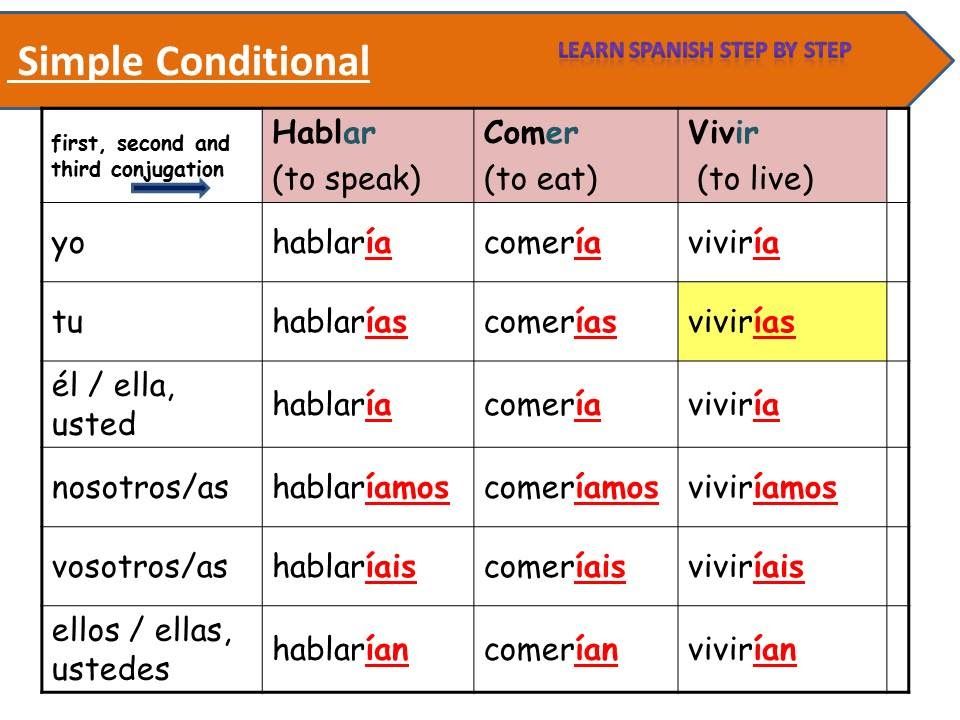Click to see all conjugation charts of querer in every tense
In this Spanish conjugation lesson we will learn how to conjugate the verb querer in the Condicional tense of the Indicativo mood. It means we will see step by step how to create and translate forms of each grammatical person.
This lesson is specifically about the querer verb conjugation. For an overview of Simple Tenses conjugation have a look at the Simple Tenses Conjugation Chart.
You may also see the Video Presentation on how to conjugate verbs in Condicional. It’s embedded below, but using the above link you will find additional information on conjugation in this tense as well as explanation of exceptions and special cases.
How to translate Condicional to English
Note that the phrases in English provided below next to each conjugation are not direct translations from Spanish to English. They are usually the closest general equivalents. The example differences are:- In Spanish conjugation, there is the form usted in the third person singular. But this person does not translate to the English third person singular. It translates to the so called formal you and uses the inflected form which is most often represented as he/she/it in English conjugation charts.
- Similar situation happens in the third person plural, where ustedes translates to the English plural formal you but uses the form which corresponds to the they form in English.
- Tenses are used differently in Spanish and English, so the actual translation should always take into account the context and focus on translating the meaning, not just words.
- In both languages each verb may have multiple meanings and not every meaning translates directly to the other language. Here also, the context and focusing on the particular meaning helps to create the most accurate translation.
Step by step instructions
Condicional belongs to the simple tenses group, which means that all of the inflected forms are one word long. There are also compound (compuesto) tenses in the Spanish language, where each conjugated form consists of two words. The verb querer has an irregular conjugation in the Condicional tense of the Indicativo mood. The basis for this conjugation is an irregular stem querr, but all the endings stay the same as in the regular conjugationUse the irregular stem querr in each person Next, add to this irregular stem the endings specific to each person In this tense we use the exact same endings in each of the three conjugation groups -ar, -er, -ir. See the image on the side showing all the six endings. Note both the colors and shapes of the letters. They are arranged to help you find patterns and make it easier to remember these endings.Also notice that in verb groups -er and -ir all six endings in both Pretéterito Imperfecto and Condicional tenses are the same. Good tip to remember. The only difference is that the Condicional uses the entire infinitive as the stem. Add the regular ending -ía for the first person singular in order to get querría:
- yo querría – I would want
- tú querrías – you would want
- él querría – he would want
- ella querría – she would want
- usted querría – (formal) you would want
- nosotros querríamos – we would want
- nosotras querríamos – (feminine) we would want
- vosotros querríais – (plural) you would want
- vosotras querríais – (feminine, plural) you would want
- ellos querrían – they would want
- ellas querrían – (feminine) they would want
- ustedes querrían – (formal, plural) you would want
That’s it! The conjugation is now complete. Put together, the conjugation chart looks like this:
| yo | querría | I would want |
| tú | querrías | you would want |
| él/ella/usted | querría | he/she/it would want |
| nosotros/nosotras | querríamos | we would want |
| vosotros/vosotras | querríais | you would want |
| ellos/ellas/ustedes | querrían | they would want |
But do not end your session yet – it is very important to repeat and practice the material in order to retain it. Check below for example phrases and suggestions.
Example sentences
Querría pagar con la tarjeta de crédito, si no es problema.
I would like to pay by credit card, if it's not a problem.
Querría comprar un billete de ida y vuelta para Madrid, por favor.
I'd like to buy a return ticket for Madrid, please.
Next Steps to Perfection
|
Report a mistake | Give feedback
Thank you very much for making the effort to contact us!
We strive to provide the highest quality content and we greatly appreciate even the smallest suggestions:
We strive to provide the highest quality content and we greatly appreciate even the smallest suggestions:



